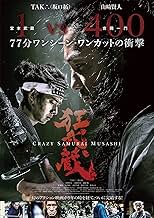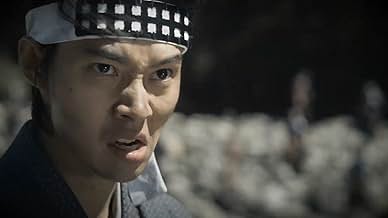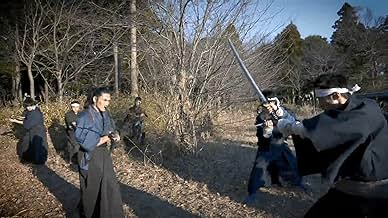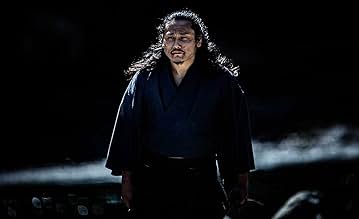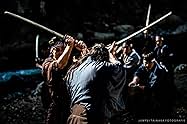Kyô Samurai Musashi
- 2020
- 1h 31min
CALIFICACIÓN DE IMDb
4.6/10
1.1 k
TU CALIFICACIÓN
Agrega una trama en tu idiomaThe most famous battle of the swordsman Miyamoto Musashi. Miyamoto fights against 588 enemies, one after the other. There is no room for error, no room for trivial, outdated, or unconvincing... Leer todoThe most famous battle of the swordsman Miyamoto Musashi. Miyamoto fights against 588 enemies, one after the other. There is no room for error, no room for trivial, outdated, or unconvincing movements.The most famous battle of the swordsman Miyamoto Musashi. Miyamoto fights against 588 enemies, one after the other. There is no room for error, no room for trivial, outdated, or unconvincing movements.
- Dirección
- Guionista
- Todo el elenco y el equipo
- Producción, taquilla y más en IMDbPro
Opiniones destacadas
Miyamoto Musashi was a very interesting Japanese Ronin in Japan's era's of swordsmen and Samurai history. Throw in Tak Sakguchi playing Musashi and I was all set for an amazing action film. How wrong I was!
It dragged on and on with poor fight choreography and too few extras playing his enemies (it became very apparent, after 10 minutes, that the same dead guys were coming back time and time again). There were no exiting moments, no edge of your seat grippers but, there were many sword style errors; which in real life he would have been killed.
Overall i think it was poorly conceived, directed and acted with terrible choreography.
A brief HISTORY of the warrior who was the Bruce Lee of ancient Japanese swordsmen. Miyamoto Musashi, also known as Shinmen Musashi no Kami Fujiwara no Harunobu, Shinmen Takezo, Miyamoto Bennosuke or, by his Buddhist name, Niten Doraku, was a Japanese swordsman, philosopher, strategist, writer and Ronin. Musashi, as he was often simply known, became renowned through stories of his unique double-bladed swordsmanship and undefeated record in his 61 duels. He is considered a Kensei, a sword-saint of Japan. He was the founder of the Niten Ichi-ryu, or Nito Ichi-ryu, style of swordsmanship, and in his final years authored The Book of Five Rings and Dokkodo. Both documents were given to Terao Magonojo, the most important of Musashi's students, seven days before Musashi's death. The Book of Five Rings deals primarily with the character of his Niten Ichi-ryu school in a concrete sense, i.e., his own practical martial art and its generic significance; The Path of Aloneness, on the other hand, deals with the ideas that lie behind it, as well as his life's philosophy in a few short aphoristic sentences. Born:Shinmen Bennosuke, c.1584, Harima Province or Mimasaka Province, Japan. Died:June 13, 1645, Higo Province, Japan.
A brief HISTORY of the warrior who was the Bruce Lee of ancient Japanese swordsmen. Miyamoto Musashi, also known as Shinmen Musashi no Kami Fujiwara no Harunobu, Shinmen Takezo, Miyamoto Bennosuke or, by his Buddhist name, Niten Doraku, was a Japanese swordsman, philosopher, strategist, writer and Ronin. Musashi, as he was often simply known, became renowned through stories of his unique double-bladed swordsmanship and undefeated record in his 61 duels. He is considered a Kensei, a sword-saint of Japan. He was the founder of the Niten Ichi-ryu, or Nito Ichi-ryu, style of swordsmanship, and in his final years authored The Book of Five Rings and Dokkodo. Both documents were given to Terao Magonojo, the most important of Musashi's students, seven days before Musashi's death. The Book of Five Rings deals primarily with the character of his Niten Ichi-ryu school in a concrete sense, i.e., his own practical martial art and its generic significance; The Path of Aloneness, on the other hand, deals with the ideas that lie behind it, as well as his life's philosophy in a few short aphoristic sentences. Born:Shinmen Bennosuke, c.1584, Harima Province or Mimasaka Province, Japan. Died:June 13, 1645, Higo Province, Japan.
I appreciate a good gimmick and an indie film that tries to go big, but this was just exhausting. The reason anyone will watch Crazy Samurai Musashi is the 70 something minute long one-shot action scene that stretches from the opening title almost to the very end. Unfortunately the very same scene is the movie's biggest downfall.
I will cut this movie a lot of slack. Obviously there wasn't a big budget and they had to squeeze every penny very hard. The talent on display here is generally fantastic, especially from main actor Tak Sakaguchi whose other roles I shall immediately seek out, the scenery is used well and very plausible. The choreography is deliberately non-flashy and rather realistic which I appreciate as a pupil of japanese swordsmanship myself. The one-shot action scene however wasn't the most compelling choice to show all of this talent off.
Every passing minute it becomes increasingly apparent how the scene was done as not only individual move lists get recycled like a standard fighting animation in a videogame, but rather entire sections of choreography. There's also a lot of obvious body armor on the stunt guys. I got most of my entertainment value from guessing the next move. Someone's looking suspiciously bulky? Belly cut! Someone's wearing a very obvious big hair wig? Gee I wonder who's getting hit in the head. Then there's the same guy who always stumbles into frame, gets tripped and cut in the back while falling. The lack of extras is a very glaring flaw. Everytime someone gets killed he literally runs out of frame to re-emerge unharmed a few moments later. It was laughably ridiculous. When enemies eventually stop running out of frame and stay on the ground you know this particular segment is about to end, our hero moves on to the next level segment where clones of the exact same guys will show up a minute later, circle around him and attack one at a time with the same pattern. Rinse and repeat for 70 minutes.
Now I understand the limitations at play here but they are rather unnecessary and self-inflicted. Had this been shot in a more conventional manner it would have been no problem to shoot and edit around them entirely and make for a more compelling, even enthralling movie. For all of its gimmicky glory the one-shot is used very amateurishly too. A lot of the action is constantly obscured by extras and the camera never moves in interesting and creative ways. The opening 30 minutes of the recent super smash hit One cut of the dead (which I assume was the inspiration) showed what fun you could have with a creative one-shot action scene. This movie felt like a chore by comparison. It just goes on and on without any tension or escalation. It's still an impressive and admirable feat, but ambition alone doesn't make a good film.
To add insult to injury the film ends in a legitimately spectacular (albeit obviously sped-up) and brutal action scene, which is shot, edited and choreographed expertly. Had the entire film been like this, with mood-setting scenes leading into gritty action, this could have become a genuine modern classic, akin to what Tsukamoto tried to achieve with his recent opus Killing. Unfortunately the director wanted to show off and ruined the amazing ingredients he had.
Every passing minute it becomes increasingly apparent how the scene was done as not only individual move lists get recycled like a standard fighting animation in a videogame, but rather entire sections of choreography. There's also a lot of obvious body armor on the stunt guys. I got most of my entertainment value from guessing the next move. Someone's looking suspiciously bulky? Belly cut! Someone's wearing a very obvious big hair wig? Gee I wonder who's getting hit in the head. Then there's the same guy who always stumbles into frame, gets tripped and cut in the back while falling. The lack of extras is a very glaring flaw. Everytime someone gets killed he literally runs out of frame to re-emerge unharmed a few moments later. It was laughably ridiculous. When enemies eventually stop running out of frame and stay on the ground you know this particular segment is about to end, our hero moves on to the next level segment where clones of the exact same guys will show up a minute later, circle around him and attack one at a time with the same pattern. Rinse and repeat for 70 minutes.
Now I understand the limitations at play here but they are rather unnecessary and self-inflicted. Had this been shot in a more conventional manner it would have been no problem to shoot and edit around them entirely and make for a more compelling, even enthralling movie. For all of its gimmicky glory the one-shot is used very amateurishly too. A lot of the action is constantly obscured by extras and the camera never moves in interesting and creative ways. The opening 30 minutes of the recent super smash hit One cut of the dead (which I assume was the inspiration) showed what fun you could have with a creative one-shot action scene. This movie felt like a chore by comparison. It just goes on and on without any tension or escalation. It's still an impressive and admirable feat, but ambition alone doesn't make a good film.
To add insult to injury the film ends in a legitimately spectacular (albeit obviously sped-up) and brutal action scene, which is shot, edited and choreographed expertly. Had the entire film been like this, with mood-setting scenes leading into gritty action, this could have become a genuine modern classic, akin to what Tsukamoto tried to achieve with his recent opus Killing. Unfortunately the director wanted to show off and ruined the amazing ingredients he had.
A good samurai movie. It does contain the longest fighting sequence, in a single shot! Fighting does feel repetitive, but you can't compare it to anything else, cuz no one else did the same thing.
Real dedication showcased. I wish they had longer first and last scenes, and a shorter fighting sequence in between.
Totally unrealistic.
95% of the actors who supposedly get killed either fall behind a tree/building, get concealed by a couple of other actors, or stumble out of the camera field of view. Only to reappear minutes later.
When the camera eventually pans around only 2-3 bodies are there instead of a pile of around 60+ corpses.
You end up watching the same repeated sequence over and over... one person at a time attacks, gets pommelled on the head, crawls off screen, and reappears a few minutes later.
I guess due to the lack of actors involved this was necessary, but this is child's playground fare in its execution. An army being represented by a dozen or so people constantly running around the cameraman is beyond acceptable.
95% of the actors who supposedly get killed either fall behind a tree/building, get concealed by a couple of other actors, or stumble out of the camera field of view. Only to reappear minutes later.
When the camera eventually pans around only 2-3 bodies are there instead of a pile of around 60+ corpses.
You end up watching the same repeated sequence over and over... one person at a time attacks, gets pommelled on the head, crawls off screen, and reappears a few minutes later.
I guess due to the lack of actors involved this was necessary, but this is child's playground fare in its execution. An army being represented by a dozen or so people constantly running around the cameraman is beyond acceptable.
Very cool to pull a "one shot" off, but man did it ever trade that for the things I expect in a hardcore samurai movie. Not even ONE decapitation. So sad...
¿Sabías que…?
- TriviaActor Tak Sakaguchi broke one finger, one rib and four of his teeth during the 77 minute battle sequence.
- ErroresMusahashi couldn't have known where to immediately find something to drink for each of his several breaks in a deserted village on the other clan's turf.
Selecciones populares
Inicia sesión para calificar y agrega a la lista de videos para obtener recomendaciones personalizadas
- How long is Crazy Samurai Musashi?Con tecnología de Alexa
Detalles
- Fecha de lanzamiento
- País de origen
- Sitio oficial
- Idioma
- También se conoce como
- Crazy Samurai Musashi
- Productoras
- Ver más créditos de la compañía en IMDbPro
- Tiempo de ejecución
- 1h 31min(91 min)
- Color
- Relación de aspecto
- 1.78 : 1
Contribuir a esta página
Sugiere una edición o agrega el contenido que falta


